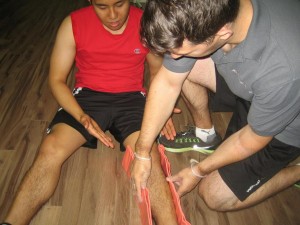A broken leg or fracture is a break or crack in one of the bones in the legs. A broken leg can have various causes which include falls, vehicular accidents and sports injuries.
What are the symptoms?
- There is swelling and tenderness
- Severe pain that becomes worse when the individual moves the affected area
- Bruising
- The affected leg becomes short or deformed and the individual finds it difficult to walk
A child with a broken leg may just stop walking and accompanied by unexplained crying which is an indication that the child sustained an injury. By enrolling in a first aid course, you will learn measures to ease the discomfort until medical treatment can be started.

Causes of a broken leg
There are various ways in which a child/adult can end up with a broken leg. The following are the common causes of a broken leg.
- Injuries that are caused by sports such as hyperextending the leg when playing contact sports, a direct blow with a hockey stick or the body of another player.
- A fall can fracture both lower leg bones, but the thighbone cannot be affected.
- Oftentimes, the three leg bones can be fractured during a vehicular accident such as in cases when the knees become stuck against the dashboard when collision occurs.
- Among children, a broken leg can be due to child abuse.
- Stress fractures are caused by monotonous force or overuse such as long distance running, but it can also develop with regular use of the bone that is weakened by certain conditions such as osteoporosis.
Complications of a broken leg
- A severe case of a broken bone may not heal quickly or completely and considered common in cases of open fractures of the tibia due to the reduced blood flow to the bone.
- A broken bone in the leg will cause pain in the knee or ankle.
- An open fracture will leave the bone exposed to fungi and bacteria that are known to cause an infection.
- A broken leg can lead to nerve and blood vessel damage
Treatment and home remedies
- Avoid moving the injured leg and do not allow the child/adult to bear any weight on the affected leg.
- Apply a cold compress over the affected area and keep the leg raised by using pillows and cushions.
- If the thighbone is broken, avoid moving the affected child/adult and seek medical help right away.
Prevention
- You have to strengthen the bone by including calcium-rich foods in the diet such as milk, yogurt and cheese. It is also recommended to take calcium or Vitamin D supplement since they helps in improving the bone strength.
- Wear appropriate shoes for the sports being played. Replace old athletic shoes regularly and discard sneakers when the tread and heel wears out.
- Try to alternative activities such as running with swimming or biking in order to prevent the development of stress fractures. When running on a sloped track, alternate the direction of the running to even out the stress place on the bones.
